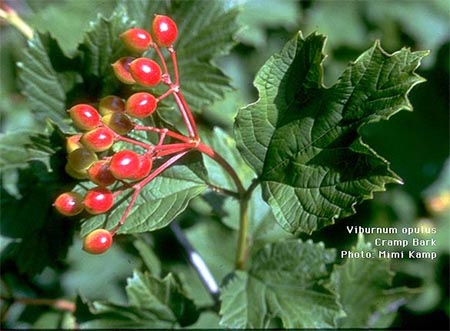
Cramp Bark is an ornamental plant, genus Viburnum, belonging to the family Adoxaceae, native to Europe and Asia. It has been used in traditional and herbal medicine as anti-spasmodic, anti-inflammatory, nervine. hypotensive agent and to treat menstrual cramps and pain, afterbirth, postpartum pains, excessive blood loss in periods, bleeding associated with the menopause, etc.
Health benefits
1. Anti-acetylcholinesterase and antioxidant effects
In the investigation of evaluate acetylcholinesterase (AChE) inhibitory and antioxidant activities of the ethyl acetate, methanol, and water extracts prepared from the branches, leaves, and fruits of Viburnum opulus and Viburnum lantana along with salicin, amentoflavone, and chlorogenic acid, found thatthe leaf methanol extract of V. opulus displayed a significantly high inhibitory effect against AChE (57.63 ± 1.23%, 87.41 ± 0.99%, and 93.19 ± 0.87% at 50, 100, and 200 μg/mL, respectively), according to the study of "Anti-acetylcholinesterase and antioxidant assets of the major components (salicin, amentoflavone, and chlorogenic acid) and the extracts of Viburnum opulus and Viburnum lantana and their total phenol and flavonoid contents" by Erdogan-Orhan I, Altun ML, Sever-Yilmaz B, Saltan G.(1)
2. Gastroduodenoprotective effects
In the demonstration of the proanthocyanidins (PA), the polymers of flavan-3-ols and it effects gastroduodenoprotective effects found that Viburnum opulus PA (VOPA, Caprifoliaceae) exerts a potent gastroduodenoprotective activity via an increase in endogenous NO generation, suppression of lipid peroxidation and mobilization of antioxidant activity and changes in glycoconjugate content of the gastroduodenal mucosa of rat, according to "Influence of Viburnum opulus proanthocyanidins on stress-induced gastrointestinal mucosal damage" by Zayachkivska OS, Gzhegotsky MR, Terletska OI, Lutsyk DA, Yaschenko AM, Dzhura OR.(2)
3. Menstrual cramps
Although there is No scientific studies have been done on whether these herbs can reduce menstrual pain, as it has been used in herbal medicine, some researchers think these herbs may have estrogen-like effects, according to the article of suggested The University of Maryland Medical Center recommends two tsps. of cramp bark, steeped in one cup of boiling-hot water, three times a day(3).
4. Excessive bleeding
Cramp bark quiets uterine cramping, and the high tannin content slows heavy bleeding, making this vibrurnums excellent choices, according to the article of " Way to stop menstrual bleeding"(4)
5. Etc.
Healthy Happy Herbs
1. Overdoses may cause allergic effect such as nausea, skin rash, etc.
2. Do not use the herb in children
3. Do not use the herb, if you are pregnant or breast feeding without permission of related filed specialist
4. Etc.
Sources
(1) http://www.ncbi.nlm.nih.gov/pubmed/21186982
(2) http://www.ncbi.nlm.nih.gov/pubmed/17218766
(3) http://www.umm.edu/altmed/articles/menstrual-pain-000052.htm
(4) http://www.livestrong.com/article/96270-stop-menstrual-bleeding/
No comments:
Post a Comment